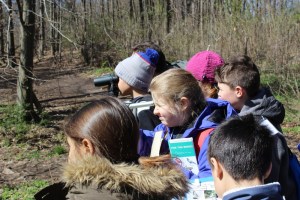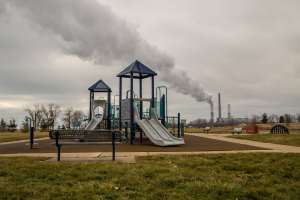Grade Level
All
minutes
Multi-day
subject
Life Science
stem practices
Obtaining, Evaluating, and Communicating Information
Activity Type:
Earth Day, outdoors, Citizen science
April brings us Citizen Science Month and Earth Day—that means it’s the perfect time to get outside, explore nature, and even help real scientists with their research! You don’t need to be an expert, just someone who enjoys spending time outdoors and making discoveries. This collection of activities offers opportunities to connect with nature, whether you’re designing your own frog species or tackling urban flooding challenges. These projects aren’t just educational, they’re genuinely fun and meaningful ways to develop your skills as community scientists and environmental stewards.
Plus, you can join the One Million Acts of Science Challenge happening right now. More than 500,000 people just like you are recording nature observations, sharing photos, and helping scientists gather important information. Because science isn’t just something that happens in labs—it happens everywhere, and everyone can be part of it!

Get Outside And Do Science
Take A Hike: Exploring Nature With Kids
Use these tips to safely explore the great outdoors on a family hike while building your observation skills. All ages, 15 minutes to 1 hour, Life Science
Build Pitfall Traps To Observe Insects And More
Learn to make a simple pitfall trap to safely capture, observe, and identify arthropods like insects and spiders. No bugs were harmed in the making of this project! All ages, 15 minutes to 1 hour, Life Science

Birding As A Gateway to Environmental Education
Get tips and tricks for exploring birding and environmental education with learners in this story about the For The Birds! program. Grades 3 to 5, 15 minutes to 1 hour, Environmental Science
Make A Home For Microbes To Understand Their Behavior
Build a home for microbes as you create a Winogradsky column, a simple ecosystem for bacteria and other microorganisms. Grades 6 to 8, Multi-day, Life Science
Make Ancient Ink With The Help Of Oak Tree Parasites
Bring history to life through biology and chemistry as you make iron oak gall ink (just like Leonardo da Vinci). Grades 6 to 8, 1 to 2 days, Chemistry
Investigating Real World Challenges
Investigate Biodiversity As You Design A Frog
Design a frog species of your own as you learn about the many ways frogs and toads adapt to their environment. All Ages, 15 min to 1 hour, Environmental Science
Down The Drain: How Water Journeys Through City Sewers
Investigate how water travels through city sewers and impacts the environment. Then, experiment to address urban flooding and pollution. Grades 3 to 8, 15 min to 1 hour, Life Science & Earth Science
Engineering A Fix For The Great Pacific Garbage Patch
Students will consider the impact of the Great Pacific Garbage Patch on the environment and marine life—and design a waste-catching device. Grades 6 to 8, Multi-day, Engineering and Technology

Environmental Justice: Evaluating Zip Codes And Pollution Burdens
Who bears the pollution burden? Use data to determine the pollution burden for a community and the systems that contribute to environmental injustice. Grades 9 to 12, 1 to 2 hours, Environmental Science
Mission Rehydrate: Water For A Thirsty Planet
Discover how astronauts recycle water on the International Space Station, then build and test your own filter to address real-world environmental issues. Grades 6 to 8, 45 to 90 minutes, Environmental Science
Mission Sensor Watch: Cool Your Community
Investigate climate science using ECOSTRESS imagery from the International Space Station. Then, hunt for heat islands and design solutions to cool your community. Grades 6 to 8, 45 to 90 minutes, Physical Science
Rewards And Neurotransmitters: How Games Can Affect Your Brain
Discover the ways reward systems like games, puzzles, and escape rooms can encourage positive or negative behaviors. Then get involved in great community science projects that use games to help neuroscience research. Grades 6-8, 15 minutes to 1 hour, Life Science
More To Explore
- Science Friday’s Earth Day Spotlight features great stories to inspire you to make Earth Day every day.
- Visit SciStarter for projects or check out Science Friday’s curated list of Community Science activities and media. Whether you teach kindergarteners or high schoolers, there’s something to spark inquiry and wonder in everyone.
- This downloadable list of Science Friday Resources for Community Science features hands-on activities for all ages, exciting reporting, and science stories that will engage and inspire anyone.
- Want to get resources like this delivered to your inbox early each month? Join the K-12 Education or Beyond the Classroom newsletters.
Educator's Toolbox
Meet the Writer
About Sandy Roberts
Sandy Roberts is Science Friday’s Education Program Manager, where she creates learning resources and experiences to advance STEM equity in all learning environments. Lately, she’s been playing with origami circuits and trying to perfect a gluten-free sourdough recipe.
